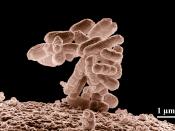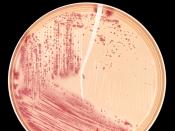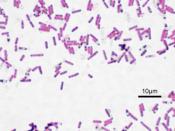Introduction
Problem
To determine the effect of ten different antibiotics on two different types of bacteria. I will test six antibiotics on Escherichia coli, and six
antibiotics on Bacillus subtilis. On Escherichia coli I will test tetracycline, chloramphenicol, furadantin, nalidixic acid, triple sulfa, and kanamycin. On Bacillus subtilis I will test streptomycin, erythromycin, novobiocin, tetracycline, chloramphenicol, and penicillin. As a side observation, I would also like to see if Bacillus subtillis shows resistance to penicillin. The use of penicillin is being reduced because of the resistance many types of bacteria are developing against it.
Hypothesis
My hypothesis is that penicillin will inhibit the most growth against Bacillus subtilis, and that tetracycline will stop Escherichia coli more effectively than the others.
Rationale
I feel that this experiment is valid because it shows how different antibiotics react to different types of bacteria. It also points out the fact that not all antibiotics work the same or that they work at all on all types of bacteria.
Materials
1 bottle of tryptic soy agar
1 culture of Escherichia coli
1 culture of Bacillus subtilis
4 sterile petri dishes
1 pack of test discs
2 sterile pipettes
2 tubes of physiological saline
1 forceps
1 wax pencil
2 sterile swabs
Method
1. Loosen the cap of the tryptic soy agar to allow it to vent. Place the bottle in a water bath at 100 degrees Centigrade so that the water level reached the level of the medium. The agar will melt in about 20 minutes.
2. Gradually cool the medium to about 45 degrees Centigrade by letting the water bath cool. Then let the medium sit for 10 minutes.
3. Pour two plates for each species of bacteria. The agar should be approximately 5 mm deep. Cover each petri dish immediately after...



Formating
Very interesting and well written but the format needs work.
0 out of 0 people found this comment useful.